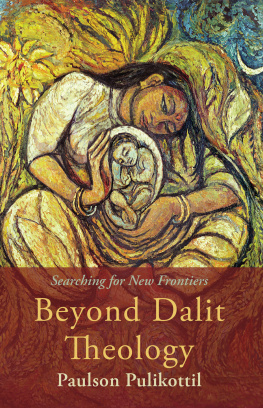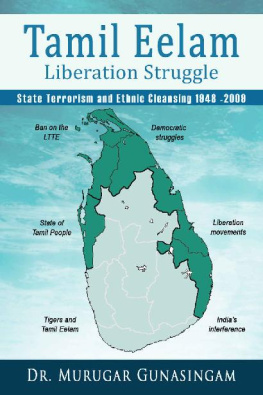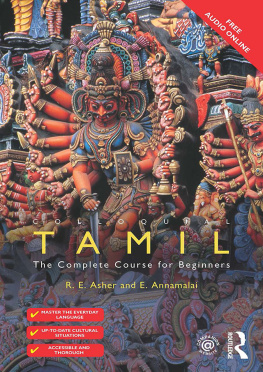TAMIL FOLK MUSIC
AS DALIT LIBERATION THEOLOGY
 | Ethnomusicology Multimedia |
Ethnomusicology Multimedia (EM) is an innovative, entrepreneurial, and cooperative effort to expand opportunities for emerging scholars in ethnomusicology by publishing first books accompanied by supplemental audiovisual materials online. Developed with funding from the Andrew W. Mellon Foundation, EM is a collaboration of the presses at Indiana and Temple universities. These presses gratefully acknowledge the help of Indiana Universitys Institute for Digital Arts and Humanities, Digital Library Program, and Archives of Traditional Music for their contributions to EMs web-based components and archiving features.
For more information and to view EM materials,
please visit www.ethnomultimedia.org .
ETHNOMUSICOLOGY MULTIMEDIA SERIES PREFACE
GUIDE TO ONLINE MEDIA EXAMPLES
Each of the audio, video, or still image media examples listed below is associated with specific passages in this book, and each example has been assigned a unique Persistent Uniform Resource Locator, or PURL. The PURL identifies a specific audio, video, or still image media example on the Ethnomusicology Multimedia website, , and so on.
To access all media associated with this book, readers must first create a free account by going to the Ethnomusicology Multimedia Project website www.ethnomultimedia.org and clicking the Sign In link. Readers will be required to read and electronically sign an End Users License Agreement (EULA) the first time they access a media example on the website. After logging in to the site there are two ways to access and play back audio, video, or still image media examples. In the Search field enter the name of the author to be taken to a webpage with information about the book and the author as well as a playlist of all media examples associated with the book. To access a specific media example, in the Search field enter the six digit PURL identifier of the example (the six digits located at the end of the full PURL address below). The reader will be taken to the web page containing that media example as well as a playlist of all the other media examples related to the book. Readers of the electronic edition of this book will simply click on the PURL address for each media example; once they have logged in to www.ethnomultimedia.org , this live link will take them directly to the media example on the Ethnomusicology Multimedia website.
TAMIL FOLK MUSIC
AS
DALIT LIBERATION
THEOLOGY
ZOE C. SHERINIAN

This book is a publication of
Indiana University Press
Office of Scholarly Publishing
Herman B Wells Library 350
1320 East 10th street
Bloomington, indiana 47405 USA
iupress.indiana.edu
Telephone orders 800-842-6796
Fax orders 812-855-7931
2014 by Zoe C. Sherinian
All rights reserved
No part of this book may be reproduced or utilized in any form or by any means, electronic or mechanical, including photocopying and recording, or by any information storage and retrieval system, without permission in writing from the publisher. The Association of American University Presses Resolution on Permissions constitutes the only exception to this prohibition.
 The paper used in this publication meets the minimum requirements of the American National Standard for Information SciencesPermanence of Paper for Printed Library Materials, ANSI Z39.48-1992.
The paper used in this publication meets the minimum requirements of the American National Standard for Information SciencesPermanence of Paper for Printed Library Materials, ANSI Z39.48-1992.
Manufactured in the United States of America
Library of Congress Cataloging-in-Publication Data
Sherinian, Zoe C.
Tamil folk music as Dalit liberation theology / Zoe C. Sherinian.
pages ; cm. (Ethnomusicology multimedia)
Includes bibliographical references and index.
ISBN 978-0-253-00233-4 (cl : alk. paper) ISBN 978-0-253-00585-4 (ebook) 1. Church musicIndiaTamil Nadu. 2. Folk musicIndiaTamil NaduHistory and criticism. 3. Folk musicReligious aspectsChristianity. 4. DalitsIndiaTamil NaduReligious life. 5. DalitsIndiaTamil NaduMusicHistory and criticism. 6. Appavoo, James Theophilus. I. Title.
ML3151.I4S44 2012
781.71'7940095482dc23
2012018988
1 2 3 4 5 19 18 17 16 15 14
To Paraai
and Elyssa
Yr vlum, eppai vlum
(Whoever wants to, can use [sing] it
however they want)
Rev. J. T. Appavoo (Paraai)
Contents
Preface
This book is an ethnomusicological ethnography of the creation, transmission, and recreation of Tamil folk music as Dalit liberation theology in India and beyond. The focus of its narrative is a heterogeneous community of poor Tamil Christian villagers, lay workers, seminary students, activists, theologians, and artists, inspired by the personality and music of a theologian/composer they call Paraai Annan (big brother with messy hair). This is an apt description and pen name for the Rev. Dr. James Theophilus Appavoo (19402005), the central trickster figure in this story. Paraai and a network of other Dalit or anti-caste actors are essential nodes in the transmission process that make up the contemporary reform movement for liturgical and theological change within the mainline Protestant Church of South India (CSI) in the state of Tamil Nadu. This movement is a grass-roots manifestation of cultural and theological agency by Dalits (or former untouchables, those oppressed by caste hierarchy from birth). While it borrows ideas from Latin American liberation theology, this movements indigenous roots lay in the Indian social gospel missions of the nineteenth century and the secular/social equality Dravidian language movement of the early twentieth century (Bate 2009, 44). Further, this Christian cultural movement takes a strong dose of intellectual inspiration from the leader of the modern Dalit movement, Dr. Bhimrao Ramjee Ambedkar, the foundational thinker who has influenced the contemporary Tamil Dalit Liberation Movement of the late twentieth century (Larbeer 2003).
This is a story about so called untouchable outcastes, those who are most socially, politically, culturally, and religiously marginalized in India through the hierarchy of caste in society and through its continued practice in the Tamil Christian churches over the last 500 years. In the last two centuries a significant number of lower- and outcastes were motivated to convert to Christianity as a means to escape at least the philosophical discourse of caste. Yet, it has only been in the last three decades that Christian outcastes, through the transformative power of Tamil folk music are changing the liturgical and political culture of the Tamil mainline churches and in the process transforming their identities This definition represents the practice of unity in resistance to oppression of all kinds including gender and class, but particularly the violent and all-pervasive system of caste hierarchy in India.
Two issues are particularly notable in Paraais music and at the center of this Dalit musico-theology movement: 1) The indigenization of Christianity through musical style, theology, and language to direct the purpose of religious discourse back to the social emancipation of the poor and oppressed in this world and in this time period; 2) the process of social identity reformation for Dalit Christians through the transformative and recreative power of music in the performance context. Appavoo developed a theory that Dalit theology should be embodied in a medium accessible to poor Dalit villagers who need it the most. While many theologians at Indian Christian seminaries experimented with creating progressive theology in musical form, or making theology singable, as Rev. Thomas Thangaraj has written (1990), it was Appavoo who transformed this idea into an accessible Dalit theologyone that is easily transmittable, usable, and thus liberating to the poor, Dalits, and women of Tamil Nadu through the alternative, recreative media of folk music and folklore (Appavoo 1986). My primary interest in studying Paraais music and its transmission is to understand through ethnographic observation and experience the efficacy of Tamil folk music to transmit a liberating theology. My intent is to understand the meaning of its use by Tamil Christians and in turn, the social dynamics in the process of creation, transmission, and re-creation of this music that Appavoo argues can result in a cultural and personal transformation from untouchable to Dalit, or liberated, through attaining an anti-caste consciousness and an active stance against caste identity.









 The paper used in this publication meets the minimum requirements of the American National Standard for Information SciencesPermanence of Paper for Printed Library Materials, ANSI Z39.48-1992.
The paper used in this publication meets the minimum requirements of the American National Standard for Information SciencesPermanence of Paper for Printed Library Materials, ANSI Z39.48-1992.